The Daugherty Water for Food Global Institute (DWFI) at the University of Nebraska played a key role in shaping the 10th World Water Forum May 18-25, 2024, with a goal of ensuring that water for food was a focus throughout the event. In total, DWFI experts participated in more than 10 sessions and events during the World Water Forum, including leading the “Water for Food and Agriculture” topic and hosting sessions at the Nature Hub Pavilion (which DWFI supported as a core partner) and the World Water Council Pavilion. DWFI also used the opportunity to hold in-person meetings with partners also engaged in the Forum.
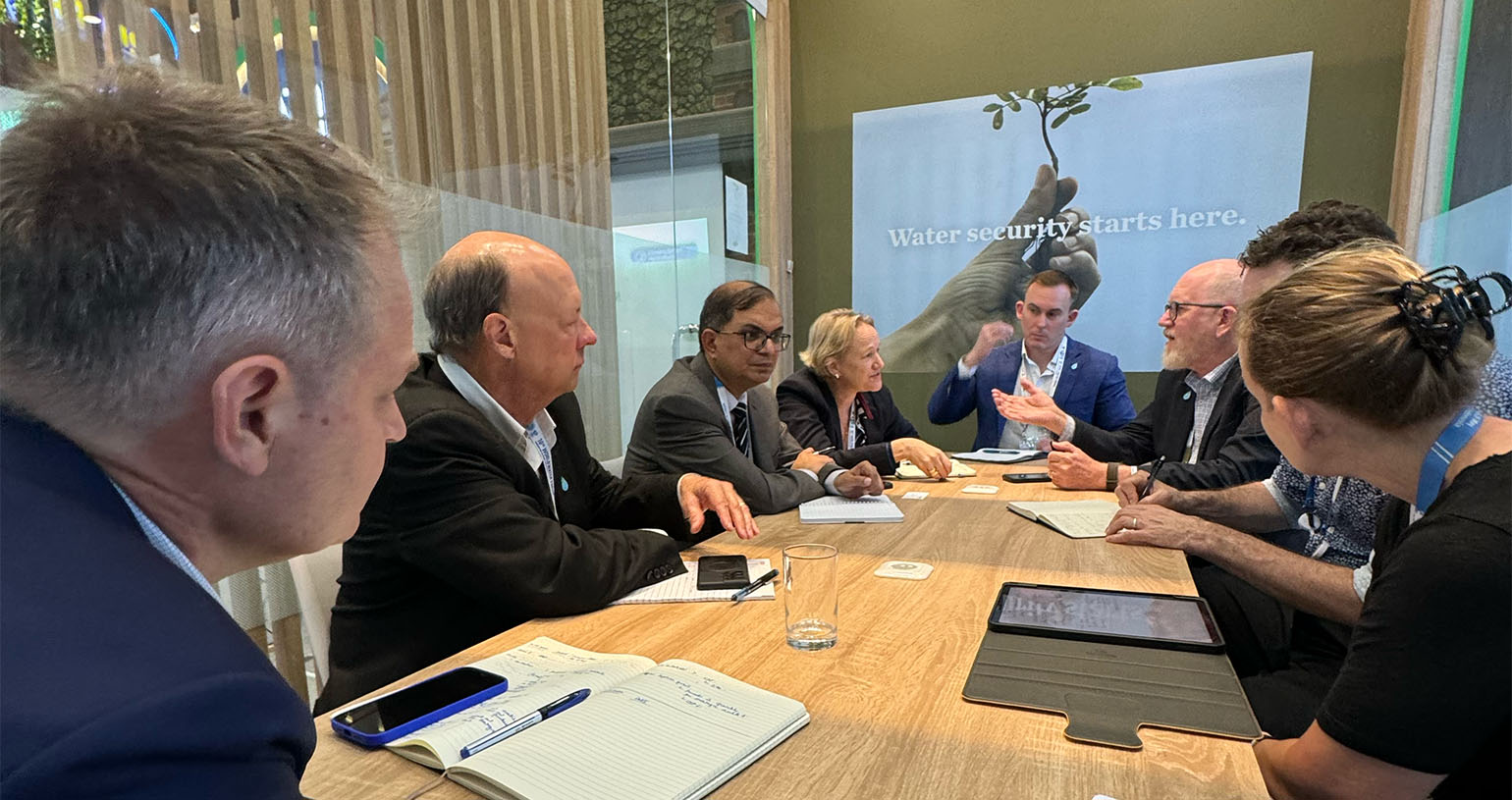
DWFI joined more than 20,000 participants and visitors from 160 countries at the Forum in Bali, Indonesia. Held every three years by the World Water Council (WWC) and a different host country, the Forum brings together stakeholders from around the globe – including heads of state and international organizations, high level government officials, experts, scholars, entrepreneurs and economists – to share their knowledge, experience and practices regarding a wide range of topics related to water. This year’s Forum included 278 discussion sessions.
DWFI is a member organization of the WWC and DWFI Executive Director Peter McCornick is currently serving his second three-year term as one of 35 members of the WWC Board of Governors, with DWFI Director of Research Christopher Neale as an alternate.
In addition to his role on the WWC, McCornick served on the 10-person International Steering Committee (ISC) Bureau, helping to plan the World Water Forum at a high level. A summary of DWFI’s additional participation in the Forum follows.
Thematic Process: Water Security and Prosperity » Water for Food and Agriculture
Six sub-themes were discussed as part of the Thematic Process of the World Water Forum and included: Water Security and Prosperity; Water for Humans and Nature; Disaster Risk Reduction and Management; Governance, Cooperation and Hydro Diplomacy; Sustainable Water Financing; and Knowledge and Innovation. Each sub-theme was further divided into five topics.
DWFI Director of Research Christopher Neale was the coordinator for “Water for Food and Agriculture'' topic under the “Water Security and Prosperity” sub-theme and coordinated four sessions within this group, drawing on DWFI leadership to serve as session leads.
Solutions for managing water for agriculture within river basins
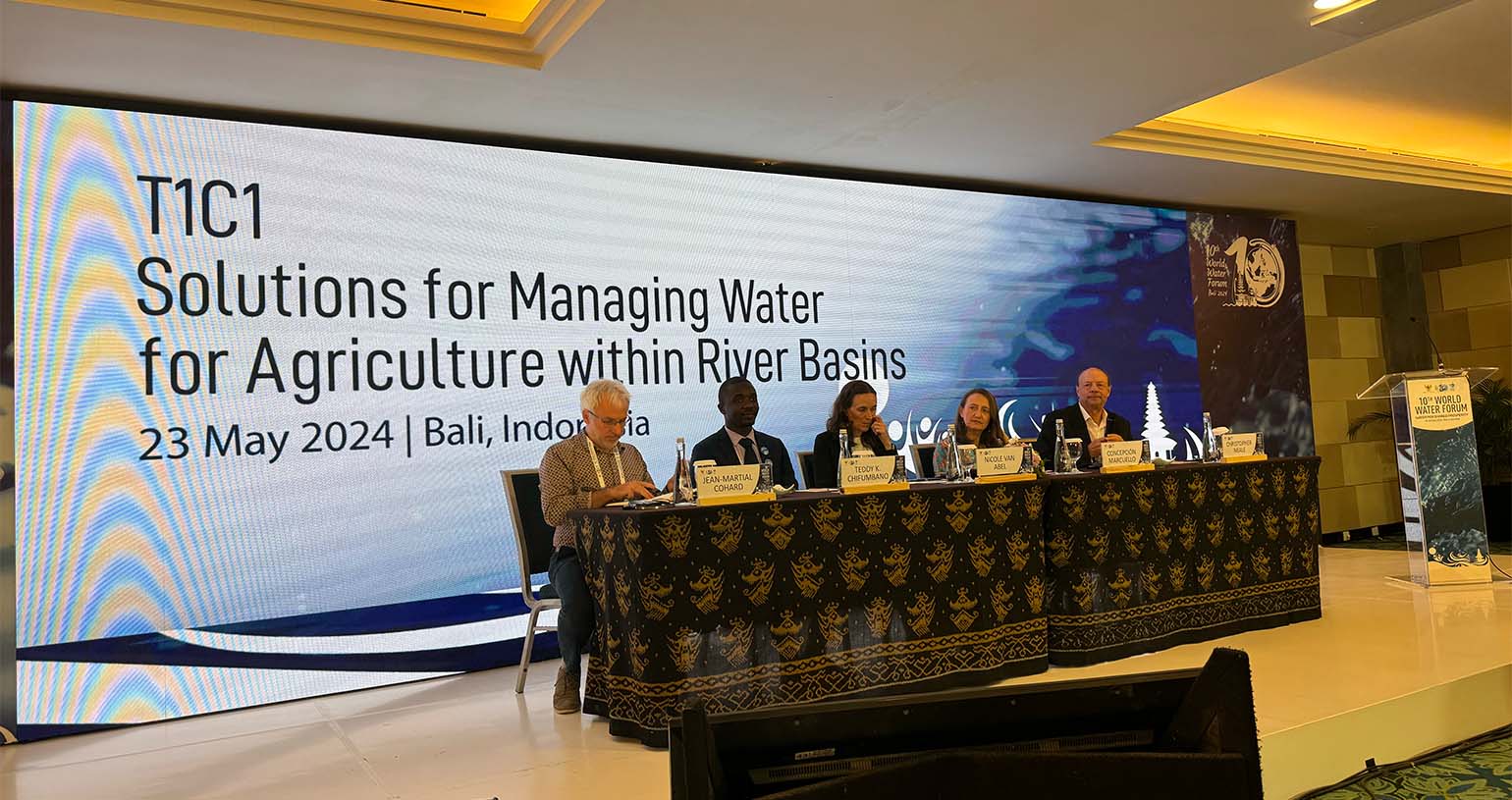
This session was led by Neale and explored solutions for managing fresh water in basins considering climate change and future weather extremes. Many options were discussed, including additional storage infrastructure, groundwater recharge, reuse of treated municipal wastewater, and application of nature-based solutions.
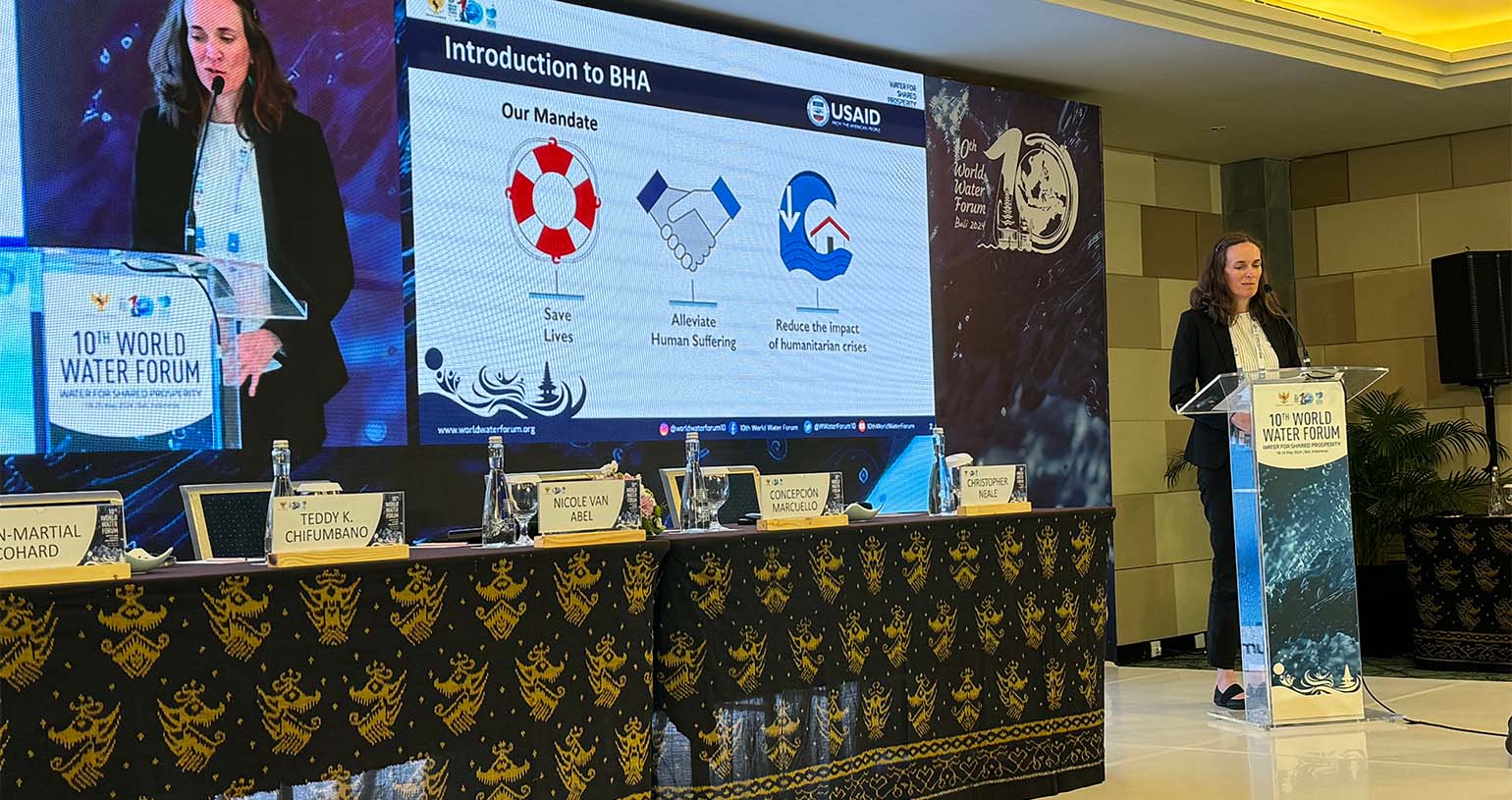
Nancy Eslick, Global Water Coordinator and Senior Deputy Assistant to the Administrator for USAID, provided opening remarks. Next, Concepción Marcuello, Spanish General Directorate for Water – Ministry for Ecological Transition and the Demographic Challenge, spoke on the planning and management of river basins in Spain. The areas use River Basin Management Plans (RBMPs) to mitigate the impacts of floods and droughts, meet socio-economic demands for water and ensure water security and resilience in spite of climate change. They also anticipate the RBMPs will decrease runoff by 25% to 40% in the future. The RBMPs were set up through the Water Act in 1985, recast in 2001 and expanded in 2021. The objective is compliance with reliability criteria for each use and RBMPs for each of the 25 river basins are on a six-year cycle.
Nicole Van Abel, Senior Water Resources Management Advisor for USAID and the Bureau for Humanitarian Assistance (BHA), provided examples of conservation activities in African watersheds used to improve food and water security. Specifically, she discussed three case studies. The Niger Integrated Resilience Program was implemented by the World Food Programme and restored watersheds by using half-moon bunds, a rainwater harvesting technique consisting of digging semilunar holes in the ground to capture rainwater running downhill. These structures allow water to seep into the soil, retaining in the subsoil a greater amount of moisture. They also prevent the loss of fertile soil.
In Zimbabwe, a cash-for-assets (CFA) program was used to improve water health. In a CFA program, cash payments are provided to participants for taking part in projects to create community or public assets to build resilience against drought such as irrigation systems, etc. In this scheme, they also encourage community leaders to include young people as collective decision makers, something that is typically reserved for the older population. The final example was using contour bunds in Ethiopia. Contour bunds are a form of micro-catchment technique and aim to slow down runoff and soil erosion and improve water infiltration in the soil. In conclusion, Van Abel said that landscape change can impact food and water security and increase resilience to shocks.
Teddy Chifumbano of the World Youth Parliament for Water, France, explored a case study from Zambia which engaged farmers, prioritized agricultural needs, and established a water right system to ensure access, which did not exist prior to the intervention.
Jean-Martial Cohard from the Institute of Geosciences and Environment (IGE), University Grenoble Alpes presented briefly on conservation efforts and sustainable approaches to support food production in Africa. The group then engaged in a discussion between panelists and members of the audience. Overall, the session focused on solutions that build resilience – mitigating impacts of floods and droughts and guaranteeing water resources for agricultural food production, food security and other uses.
Agricultural water management technologies, practices, and outreach to support smallholder farmers
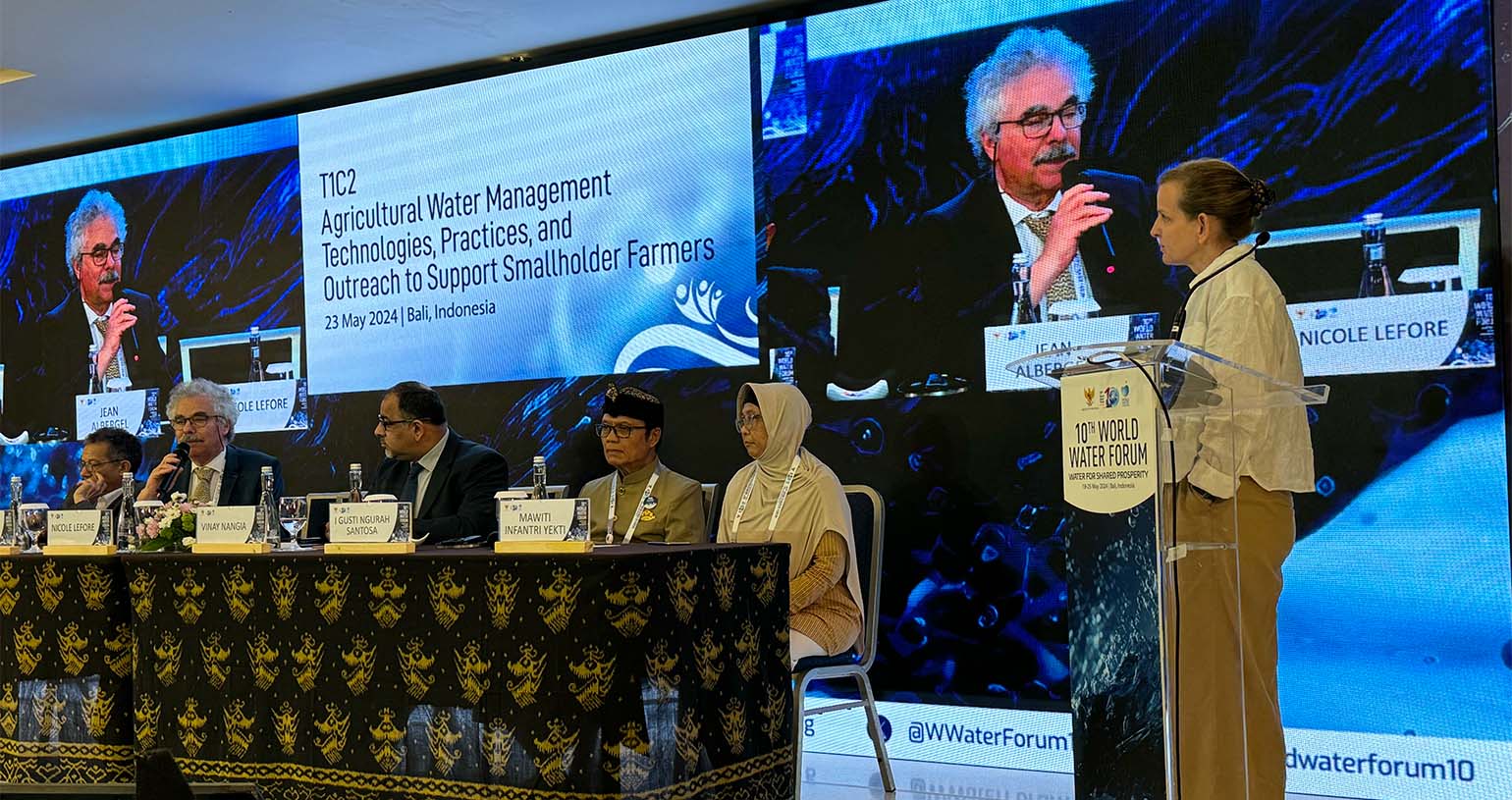
The goal of this session was to examine inclusive and scalable solutions to improve food production by smallholder farmers (women and men) through rainwater harvesting, low-cost irrigation technologies, agricultural support services and viable business models.
In this session, led by Nicole Lefore, Director of the Feed the Future Innovation Lab for Irrigation and Mechanization Systems, multiple case studies explored the topic of revitalization of irrigated areas from multiple perspectives of sustainability and showcased innovations from the ground.
Lahcen Kabiri of Moulay Ismail University, Morocco, set the stage for the session by talking about smallholder agriculture’s role at the nexus of many complex relationships, and therefore being an important part of the solution to global food and water security.
Jean Albergel, French Institute of Research for Sustainable Development, presented on Water in the Oasis: a Fascinating Model for Agro-ecology.Albergel discussed the incredible climate-stabilizing and water access benefits of oases, as well as the threats of climate change, monoculture expansion, center pivot irrigation, and tourism development. He said agro-ecological pathways will be important for maintaining oases preservation, livestock farming, and vegetation agriculture.’
Vinay Vangia, ICARDA, provided a case study of using rainwater catchment techniques as supplemental irrigation to stabilize yields during times when rainfall fails to provide sufficient moisture for normal plant growth. His case study in Iraq showed 91% and 112% average increase in yield when treatment was switched from rainfed to 100mm and 200mm supplemental irrigation.
Mawiti Infantri Yekti, Universitas Negeri Yogyakarta and Ir. I Gusti Ngurah Santosa, AEAN Eng./Bali Centre for Water Study Universitas Udayana, presented on the subak irrigation system in Indonesia, and its ability to reduce landslides, maximize yield, and manage pests through the sustainability of water distributions and striking a balance between people and environment.
In a recorded video, Claudia Ringler, International Food Policy Research Institute, provided tools and institutions to support increased sustainability of groundwater management for irrigation.
And finally, Lefore presented on women’s role in agriculture. Both at home and in public spaces, women face more constraints than men, with less access to capital, information, technology, equipment, etc. There are many projects that “reach” women, but don’t actually benefit them. Women comprise 30-70% of the agricultural sector in Africa. In order to drive farmer-led irrigation, initiatives must be gender-conscious.
Rashid Mbaziira, Executive Secretary of AMCOW, provided closing remarks on the session's relevance to policy priorities in Africa.
Key takeaways were that it is valuable to learn about and implement lessons that have emerged from traditional and ancient approaches, as well as science-based adaptation practices, on agricultural water management. Across geographical regions and agro-ecologies, smallholder farmers are trying to adapt to the impacts of climate change while meeting growing food demand. This is creating risks for smallholder farmers and the natural resources, especially water, that need to be addressed urgently.
Presenters also called for policy and practice based on the specific conditions of the context, from arid and semi-arid locations facing drought and water scarcity to island conditions in Bali experiencing problems with drainage. They recommended governance and suitable institutions to manage water in consideration of existing social and cultural contexts.
African continental institutions such as the African Ministerial Commission on Water have committed to improving opportunities for market-oriented smallholder farmers to irrigate sustainably, supporting institutional reforms on water and land tenure, encouraging the private sector involvement, and ensuring women farmer involvement. AMCOW challenges political leadership to align policies to meet the growing demands for food amid the changing climate and conditions.
Participants in the panel committed to sharing information, undertaking joint research, and supporting scholarly exchanges, particularly that support the youth as future water and irrigation scientists.
Revitalization of existing irrigated areas to be water-wise and climate-smart
Irrigation development and management interact with different systems including ecosystems, climate and society. Such linkages must be recognized and strengthened to avoid negative impacts and reinforce positive ones. In the light of this assumption, how can future irrigation revitalization guarantee the sustainable, climate-smart and efficient use of water? What are the required social and environmental safeguards to make irrigation development sustainable and equitable?
In this session, led by Neale, opening remarks were given by FAO Director of Land and Water Division Lifeng Li.
Maher Salman, FAO Senior Officer of Land and Water Division gave a presentation titled Moving Towards Sustainable Revitalization: Principles and Flagship Initiative to Map Irrigation Needs and Potential. He said the main challenge in the midst of current technological, environment and climate-related, social and economic challenges is to make sense of all the parameters. He presented an initiative to map irrigation needs and potential, setting directions for irrigation planning and development, which reconciles the needs and the potential of irrigation through a global consultative process.
Next, there was a panel discussion with Marco Arcieri, president of the International Commission on Irrigation and Drainage; Yasmin Siddiqi, director of the Agriculture, Food, Nature and Rural Development Sector Office of the Asian Development Bank; and Nizar Zaied, manager of Agriculture, Water Resource & Rural Development Economic & Social Infrastructure at the Islamic Development Bank. The panel discussed setting criteria for climate-smart and sustainable revitalization and exploiting the potential of irrigation development for embracing environmental and social safeguards.
Marie-Sara Bouloumou, advocacy officer for Water, Sanitation and Hygiene, Secours Islamique France, gave a presentation on enhancing resilience through circular water management in fragile contexts, sharing lessons from SIF’s irrigation canal rehabilitation in Syria. She said states must recognize the links between food and water security and that water should be considered a common good by states and managed equitably and sustainably in the face of resource pressures. She said states and relevant stakeholders should promote sustainable agricultural practices and protect, restore, and conserve water resources. To ensure climate justice through agricultural issues, there must also be a prioritization of adaptation to climate change.
A series of case studies on irrigation development, management, water efficiency, and sensor technology followed. Lance Gore, principal portfolio management/water resources specialist for the Asian Development Bank, provided a case study on low carbon irrigation development in Asia. Since agriculture feeds humanity, carries significant environmental costs (carrying $2 trillion USD annually which stem significantly from greenhouse gas and nitrogen emissions, land-use change and water use), and is the primary driver of biodiversity loss, agriculture can not continue business as usual, he said and provided examples from Asia.
Kenji Washino, secretary general for the International Network for Water Ecosystem in Paddy Field - Japan Committee presented on on-farm irrigation management: improved paddy rice production for mitigation and adaptation. In Japan, increasing natural disasters have caused crop damage and an aging and declining population has led to a deterioration in agricultural communities. He said the irrigation sector can counter this by increasing water productivity in paddy agriculture and contributing to the reduction in greenhouse gas emissions by adopting the alternative wetting and drying (AWD) technique in paddy fields. AWD is a water-saving technology that farmers can apply to reduce their irrigation water use in rice fields without any yield penalty. In AWD, irrigation water is applied a few days after the disappearance of the ponded water. Hence, the field is alternately flooded and non-flooded.
Martino Melli, head of office and the Cairo Italian Agency for Development Cooperation, provided a case study on water efficiency: Egypt’s case study on promoting water efficiency in the Nile Valley for better living conditions. This presentation provided ways to improve the living conditions and revenues of smallholder farmers and their communities through a sustainable and integrated approach to rural development addressing resource scarcity.
Overall, the session demonstrated the added value of established approaches for harnessing multiple benefits of irrigation system revitalization, including, but not limited to, the thematic topics of consumptive use of water, water measurements and accounting, impacts to downstream users, salinity and drainage, alternative irrigation methods for rice production and other crops to reduce methane and nitrous oxide emissions, as well as alternative and renewable energy sources for irrigation.
Effective governance approaches for agricultural water management
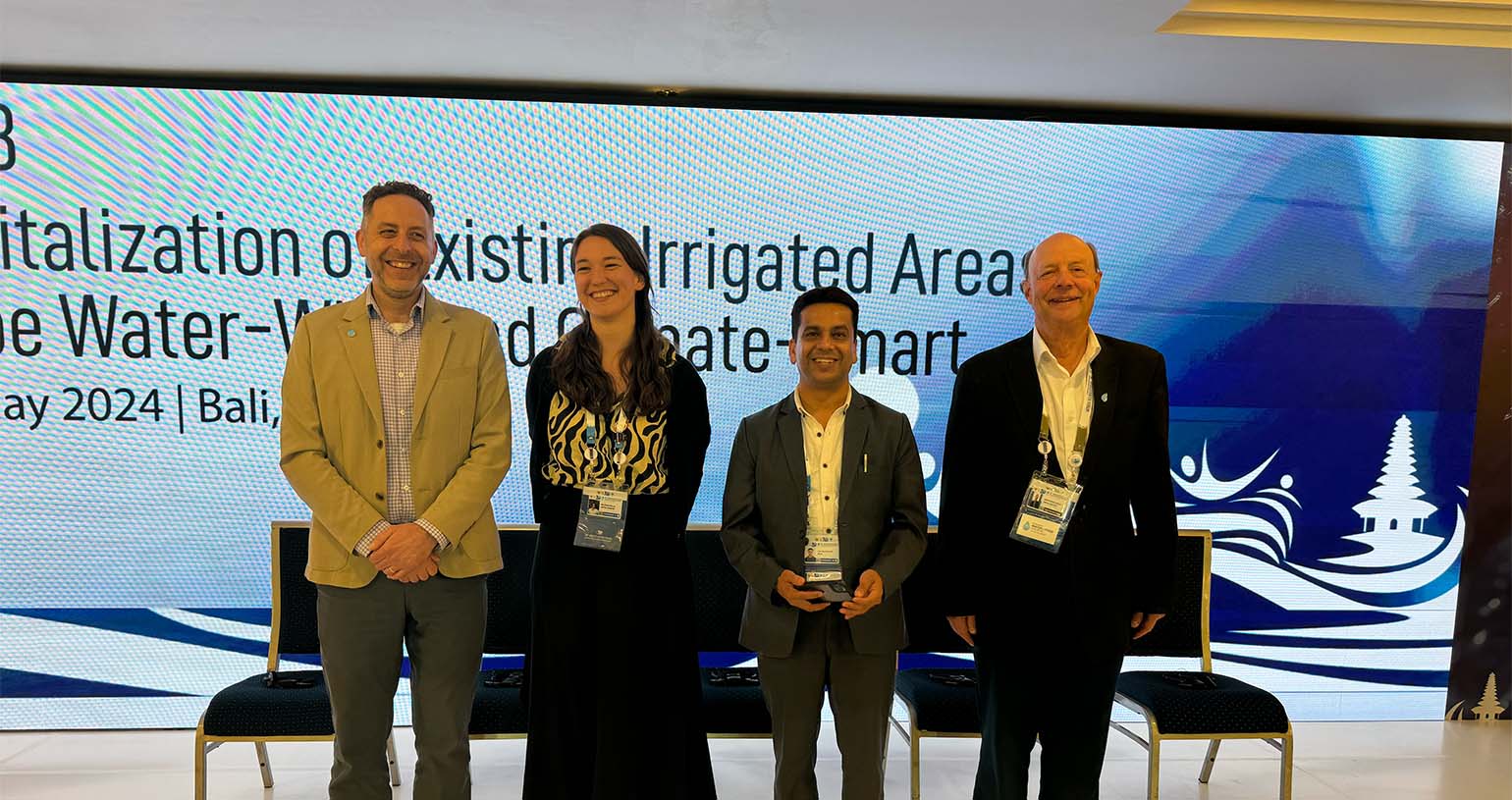
This session explored organizational and governance approaches working in different parts of the world for surface and groundwater management for agriculture, including local traditional and customary systems of irrigation water management, water user associations, local water markets and other forms of water governance to ensure equitable access to water.
DWFI Director of Policy Nick Brozović led the session and framed the discussion by providing an overview of water governance. Irrigation provides food security to support economic development and local context is extremely important, he said. The challenge is to translate best practices governance, particularly bridging between smallholder and high-productivity large scale settings. Brozović said that managing groundwater is harder than managing surface water. Surface water resources are typically societally managed and relatively well understood; groundwater resources, however, are often hidden and more difficult to conceptualize. He said it was important to note that current and future irrigation expansion is dominated by private finance and operations.
Sophie Bhalla of the Morwick G360 Groundwater Research Institute at the University of Guelph used a case study of Tunisia to discuss the implications of a fragile political system and poor water management on the overexploitation of groundwater resources. Her research found that the collapse of groundwater user groups can only be delayed, not prevented in stressed groundwater systems and this is accomplished as a result of local leadership likely from a lack of trust in government.
Ajay Adhikari, project director at the Department of Water Resources and Irrigation for the government of Nepal, explained a project for innovative groundwater irrigation management in Nepal using the example of Madhesh province in Terai, the grain basket of Nepal and an area with no alternative source of irrigation available beyond nearby rivers.
Through the Mechanized Irrigation Innovation Project, an initiative by the government of Nepal and the Asian Development Bank, the first DBO (design build operate) modality in Nepal’s irrigation sector was set up in the area with the establishment of an independent irrigation management company. The project included a prepaid meter system with a smart card for water fee collection to make the system self sustainable and maintain supervisory control, along with a farmer support system. The system then provides reliable service to farmers and the use of modern and innovative irrigation technology. While the project is ongoing, it is expected that farmers’ yields will increase and the overall benefit from the project will be $130 million per year, with the goal to move farmers in the area from subsistence-based agriculture to industrial agriculture.
Brozović named three policy drivers of groundwater management, which include: 1) Very active surface-water groundwater interaction 2) Long-term aquifer depletion 3) Concerning water quality issues. From the Western United States, he said we’ve learned about the need for building trust, good data, using a portfolio of approaches, assuring performance of the governance and funding availability.
Brozović used the example of water management in the U.S. High Plains area, specifically the state of Nebraska and its local governance of water through its 23 Natural Resources Districts with the ability and willingness to set and enforce rules.
To sum up the session, Brozović said policymakers should focus on capacity building and entrepreneurship. While some technologies can be applied across context, there also needs to be sensitivity to supply chain and fairness issues. Overall, farmers’ perspectives need to be considered when drafting any water policy.
It is well understood that the institutional and policy contexts of governance are highly variable
within and across regions. Studying the localization of organizational and governance approaches is critical to understanding general principles for effective agricultural water management.
Regional Process: Americas
The regional process of the World Water Forum divided the world into four regions — Asia-Pacific, Mediterranean, America, and Africa — and sessions focused on collaboration and finding the best solutions for water-related issues, addressing water challenges within each region and between interconnected regions.
Neale served as a co-coordinator for the “Americas” regional process and four sessions were presented within this region.
Challenges in North America: Water and Sanitation, Water for Agriculture
This session addressed the challenges facing the water and sanitation sectors and agricultural sector in North America. In the urban areas, these challenges include aging infrastructure, cyber threats, contaminants such as lead and PFAS, climate change stressors, and financing. In the agricultural areas, flood and drought extreme events and shifting climate and precipitation patterns pose challenges for food production both in the rainfed and irrigated agricultural areas.
Dale Jacobson, PE, principal with DD Consulting and former World Water Council Governor, discussed water and wastewater infrastructure in North America and more specifically, the United States. While it is largely developed, there remain challenges going forward. Discharge standards have been increased requiring tertiary treatment for some facilities. Older facilities need equipment upgrades due to age alone. Treatment technologies have also changed, offering new paths to achieving discharge standards. Population growth over 50 years has also resulted in the need for increased treatment capacity. Collection system issues include infiltration/inflow correction, replacement/rehabilitation of older systems, combined sewer overflow correction and expansion of collector and interceptor Sewers.
Agriculture in the semi-arid western US and Canada depend on irrigation for economically viable crop production, thus snow accumulation and runoff in the Rocky Mountains is an important source of water for agriculture. The prolonged drought over the last two decades has impacted water availability in the Colorado River basin and in Northern California, resulting in the over pumping of the aquifers as an additional source of water to maintain year-round crop production as well as permanent tree crops such as fruits and nuts. In the Central Plains, the pumping from the Ogallala High Plains Aquifer for irrigation purposes has led to the extraction of over 50% of the saturated thickness in some areas, as the pumping rate has typically been above the natural recharge in these areas.
Neale shared the governance structure of the Natural Resource Districts (NRDs) in the state of Nebraska, U.S.A., which are local government entities with broad responsibilities to protect the state's natural resources. Major Nebraska river basins form the boundaries rather than county lines, enabling districts to respond best to local needs. Locally-elected boards of directors govern districts and much of the funding comes from local property taxes. Nebraska is situated above 70% of the total water contained in the Ogallala High Plains Aquifer. While water in most areas of the aquifer are in decline, water levels have risen in some parts of Nebraska, in part due NRDs and the sustainable governance of water in Nebraska. Neale also pointed to the Nebraska Water Productivity Report, which assessed the water productivity of crop and livestock production, as well as the water, energy and carbon footprint of ethanol in Nebraska.
Neale addressed the surface and groundwater use governance structures that need to be in place to address sustainability in multi-use watersheds with additional consumptive uses of water from agriculture as irrigation is introduced in both the US and Canada to mitigate climate change effects.
Other sessions within the “Americas” Regional Process included:
- Water Security and Water for Humans
- Using knowledge and innovation to finance the water sector
- Water Cooperation and Peace in South America
Regional Process: Americas Synthesis Session
After all sessions in the regional process had been held, each region met to discuss and identify priority actions related to the water crisis at the local and regional levels, including determining the scope of the regions. Each coordinator shared the outcomes of a year-long discussion and disseminated real ideas in addressing regional water challenges. The forum also provided an understanding of common water priority aspects, which often vary from one region to another.
Some important takeaways:
- Invest in sustainable and multipurpose water infrastructure, as well as commit to the conservation and recovery of ecosystems as natural infrastructure, essential to close existing gaps in coverage, considering the particular needs of women, indigenous peoples, Afro-descendants, and other vulnerable groups.
- Strengthen institutions and regulatory frameworks, as well as coordination mechanisms at all levels.
- Generate monitoring systems to support decision-making; evaluate the effectiveness of water management instruments and improve transparency.
- Promote dialogue and coordination mechanisms; capacity building through existing regional platforms and instruments, particularly in transboundary basins.
- Foster an intersectoral and multilevel perspective to diversify financing and promote greater flexibility in its management.
- Carrying out applied research and capacity building are key in the development and establishment of circular economy systems that allow greater efficiency in the use of water resources.
- Invest in the development of institutional human capital capacities and the promotion of career plans. It is essential to integrate young people and generational renewal.
World Water Council (WWC) President Loïc Fauchon emphasized the importance of regional processes and their significant role within the broader water discussions of the week.
"The spirit of collaboration not only serves as a strong foundation for sustainable future water management but also plays a crucial role in the success of water management in each region," Fauchon said.
Full synthesis: https://drive.google.com/file/d/1Wvyg4D-wyNivZX5yfJmiuCRu-lsv_A9h/view
World Water Council Pavilion
Water for Food & Agriculture: A Resilient Future
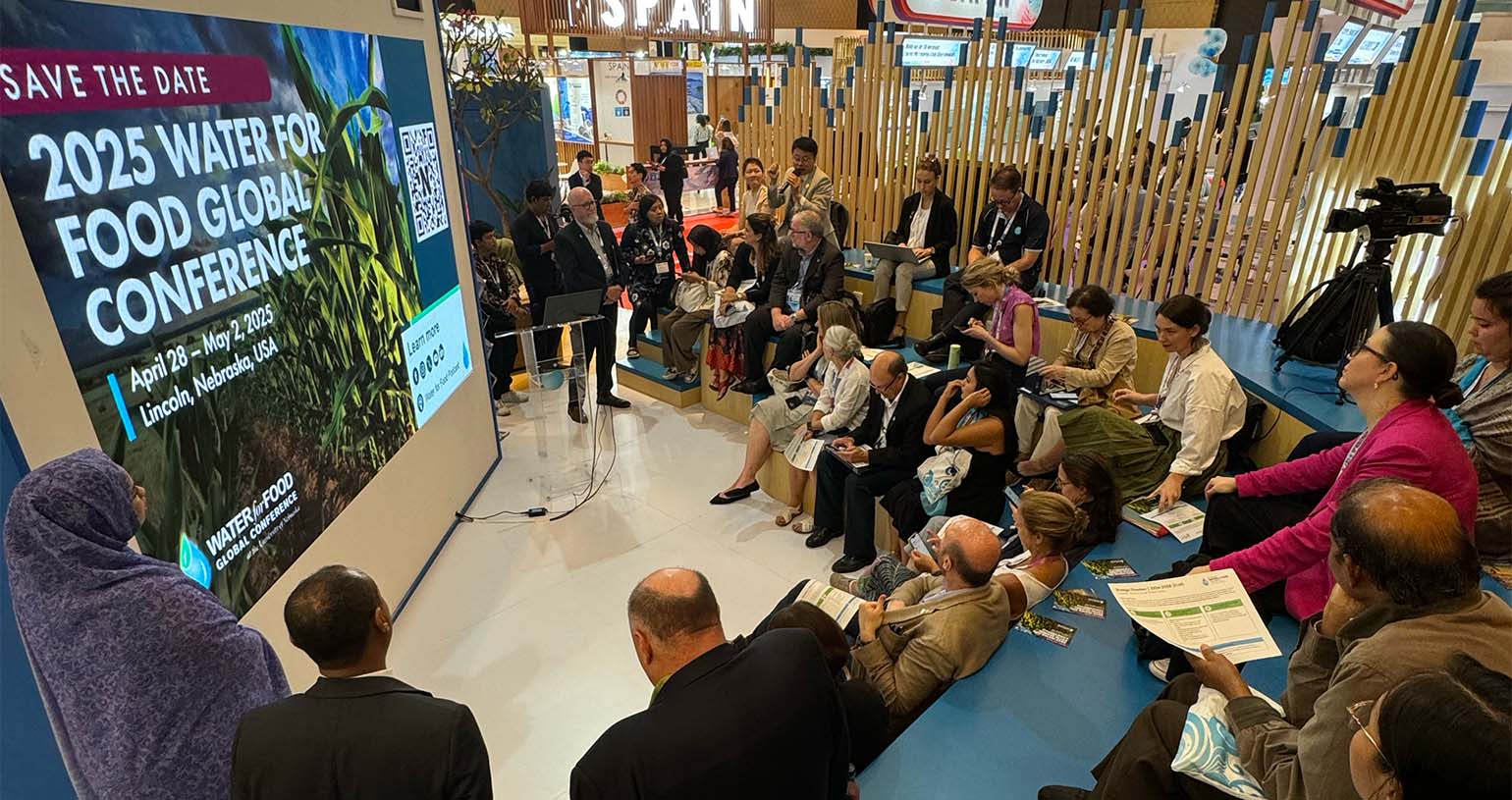
In this special session at the World Water Council Pavilion, DWFI addressed how to ensure long-term availability of clean water and nutritious food in the face of a changing climate. DWFI Executive Director Peter McCornick led the discussion, asking the DWFI team to summarize the World Water Forum sessions in which they participated and draw key messages from each. Input from audience members on strategies for addressing the global challenges of water scarcity was also solicited.
McCornick emphasized the importance of understanding water and agriculture as a complex and interconnected system, highlighting the necessity of considering not only technological and policy-based solutions but also the significant role of human factors such as behaviors, incentives, and institutions in effective water management. He also stressed the need for patience and persistent effort in tackling these long-term challenges, acknowledging that there are no immediate or easy solutions.
The subsequent discussion delved into various critical aspects of water management for agriculture:
- Indigenous and ancient knowledge: Participants engaged in a discussion about the importance of incorporating indigenous knowledge and local practices into water management strategies. They acknowledged the challenges associated with accessing and respectfully utilizing this knowledge. It was suggested that indigenous communities, with their rich history of water stewardship and deep understanding of local ecosystems, possess invaluable insights that could significantly contribute to the development of sustainable water management practices.
- Youth and farmer involvement: Farmer groups and youth should be fully involved in and buy into the process with trust in the actors involved when it comes to solutions or policy.
- Technology: The session explored the potential of promising technologies in the field of water management. These included remote sensing technologies for accurate monitoring of water resources; data analytics and artificial intelligence for making informed decisions; and innovative approaches to water treatment and desalination, as well as reuse for optimizing water usage. Participants discussed how these technologies could enhance efficiency, sustainability, and resilience in water management practices but that investments in technology alone while bypassing governance can actually increase risk.
- Finance: The crucial role of finance in water management emerged as a key topic of discussion. Participants explored strategies for mobilizing private capital to invest in water solutions, recognizing the need to mitigate risks and enhance the attractiveness of these investments for private investors. Various mechanisms were discussed, including blended finance models, guarantees, and other innovative financial instruments, as potential avenues for encouraging greater investment in sustainable water management projects.
- Governance: Proactive and adaptive local governance of water with relevant data is vital in light of climate extremes, especially when it comes to groundwater. Solutions should focus on stewardship and collaboration. Water demand is growing, so the absence of strong water governance is likely to result in conflict.
Overall, the session underscored the multifaceted nature of water challenges as it relates to agriculture, emphasizing the need for integrated and collaborative approaches that transcend disciplinary boundaries. It highlighted the importance of considering social, cultural, health and economic dimensions in conjunction with technological advancements to develop holistic and sustainable water management strategies. The discussion served as a reminder that effective water management and a more resilient future requires a comprehensive approach that acknowledges the interconnectedness of water resources with human societies and the environment and there is still much work left to do.
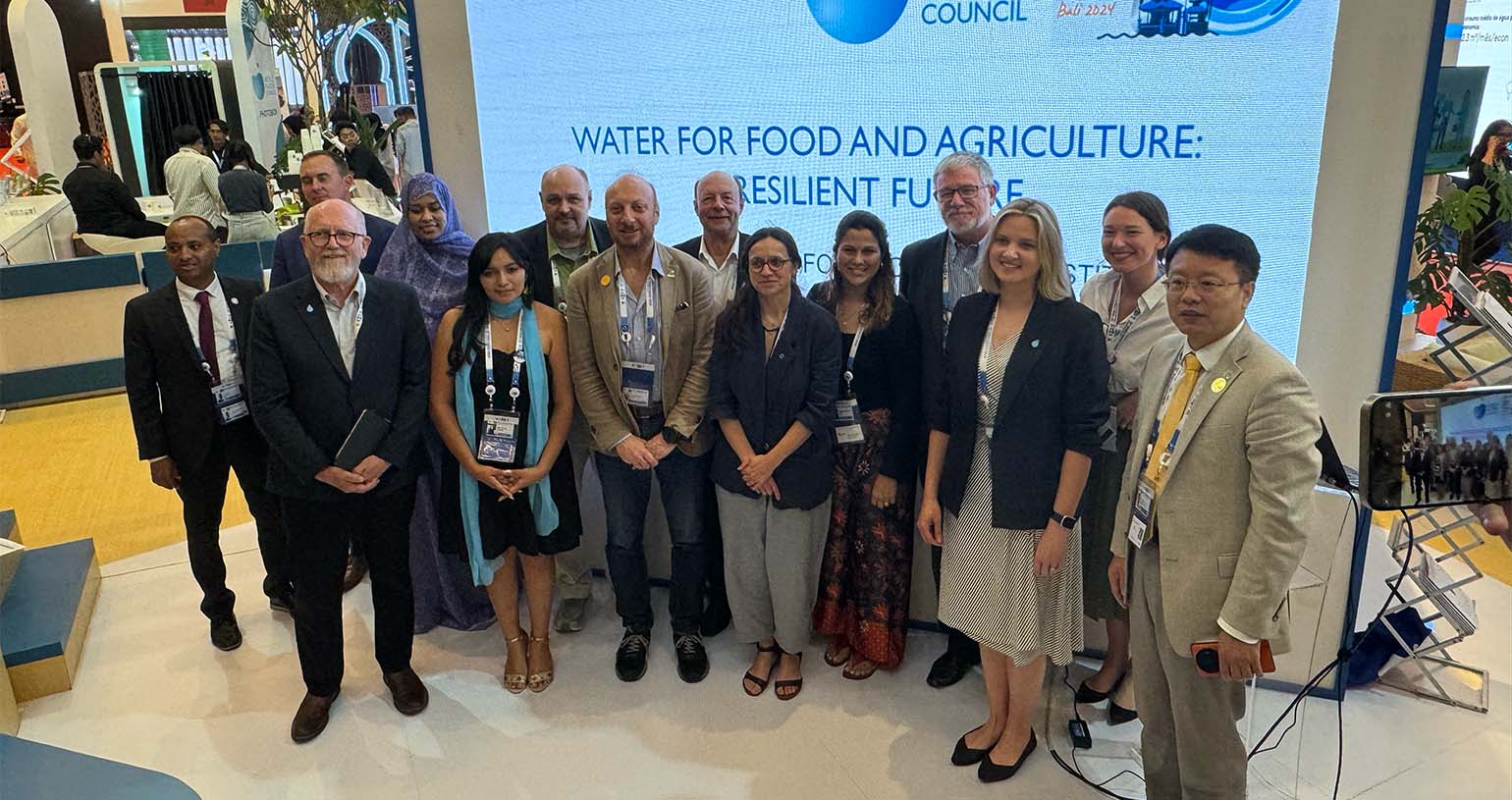
The Nature Hub
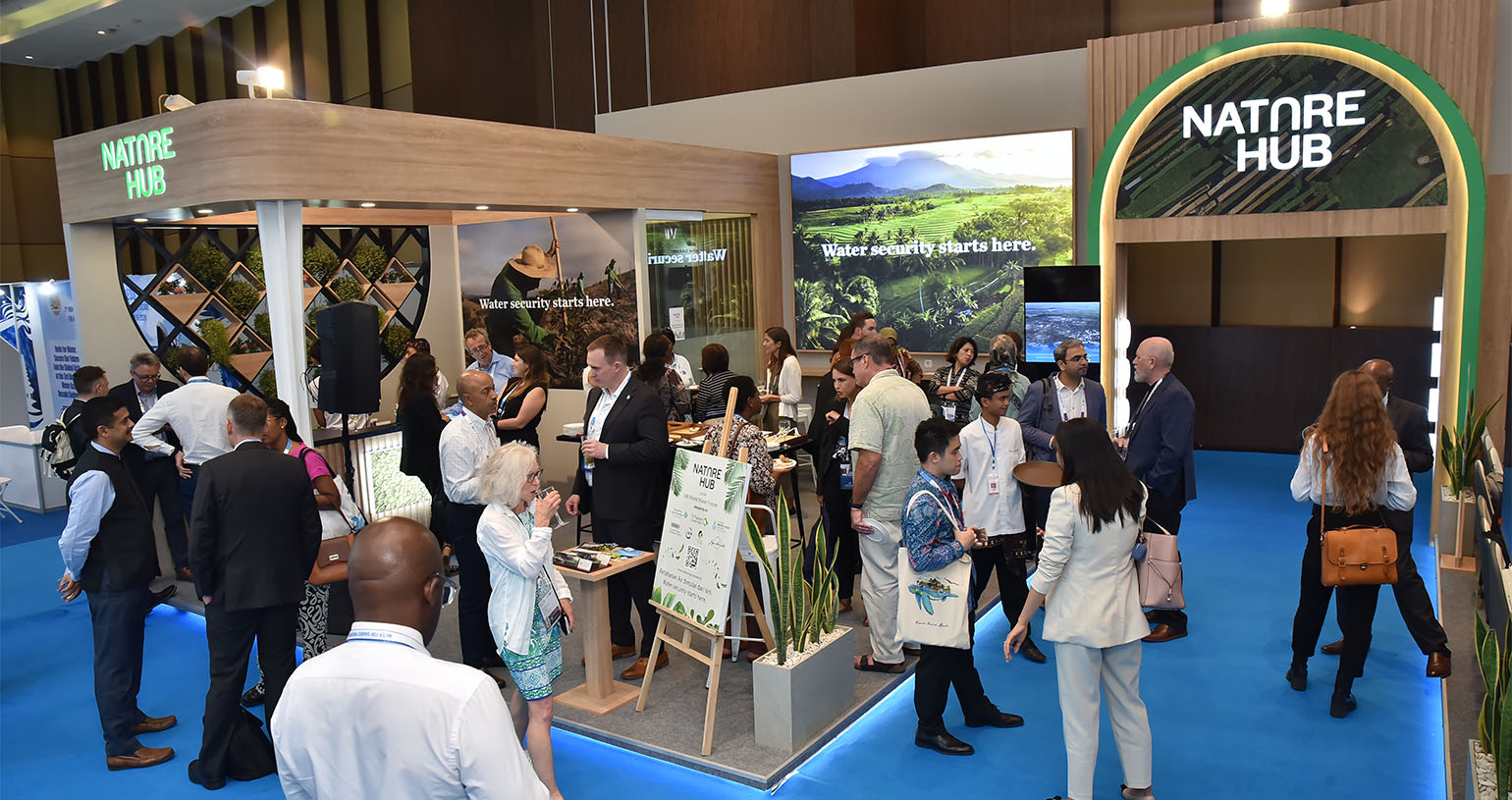
DWFI partnered with The Nature Conservancy, the International Water Management Institute (IWMI), the International Union for Conservation of Nature (IUCN), Forest Trends and several other organizations to host the Nature Hub exhibition booth. The Nature Hub served as a collaboration and networking space and an opportunity for DWFI to share promotional materials and host two special sessions.
Agricultural water use, hydrology, and policy trends: Challenges and insights for action
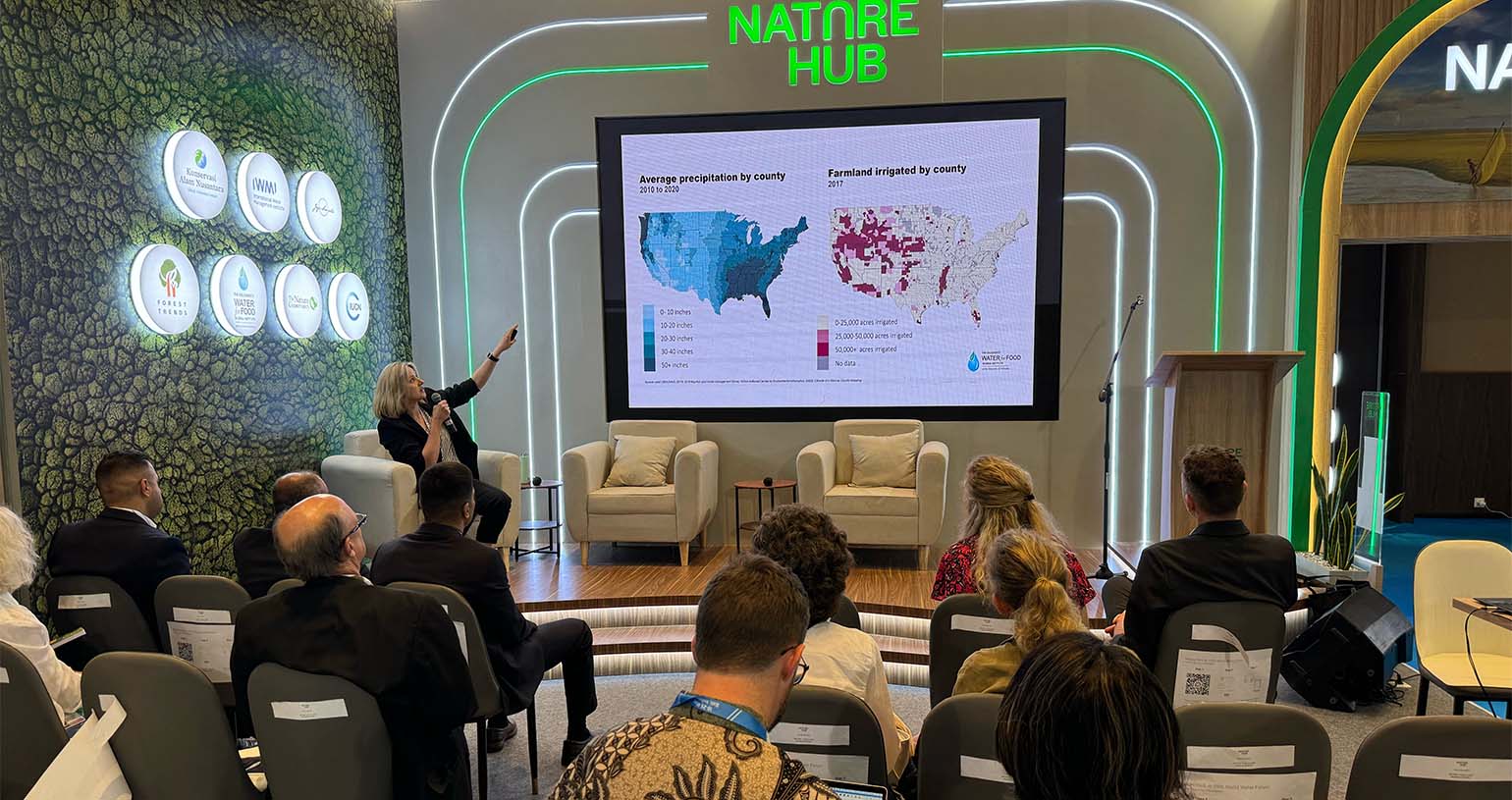
Over the last decades, water use patterns in agriculture have shifted globally. Some regions have experienced a decrease in irrigated area, while others have experienced an increase. Changes in precipitation and drought events, groundwater availability and use practices, as well as evolving policies, have all influenced irrigation trends. These changes test decisionmakers’ ability to adapt and avoid potential negative consequences to rural economies. In this session, DWFI Director of Policy Nick Brozović and DWFI Senior Program Manager Renata Rimšaitė highlighted common misconceptions about water availability, demonstrated changes in irrigation patterns across space and time, and discussed challenges and pathways toward solutions related to agricultural water risk management.
A Vital Connection: Exploring the Nexus of Water and Human Health
Water has a profound impact on human health. In this session, Jesse Bell, DWFI director of water, climate and health explored how water quantity and quality, as well as the effects of a changing climate, can significantly impact our well-being. Bell shared the efforts of the Water, Climate and Health Program at the Daugherty Water for Food Global Institute and the University of Nebraska Medical Center, which pioneers interdisciplinary research, education and collaborative solutions to public health challenges associated with water and climate in Nebraska and around the world.
Transformational Pathways for Sustainable Groundwater: the Role of Solar Irrigation
Nicole Lefore, Director of the Feed the Future Innovation Lab for Irrigation and Mechanization Systems, was invited to be a panelist on this Nature Hub side session held by the International Water Management Institute. She spoke about solar irrigation in Africa, and its opportunities, risks, and mechanisms to manage groundwater.
Side Event
The Many Faces of Drought: Monitoring Societal Impacts and Building Resilience
Drought is one of the most impactful, widespread climate-related disasters that commonly leads to significant economic and societal consequences. For example, droughts over the last century have caused numerous severe famines resulting in more deaths than any other climate-related disasters. Due to climate change, drought events will likely continue to increase in severity and frequency, which increases the economic and societal impacts of these events. Although better early warning systems have improved our ability to respond to drought events, much work is needed on implementing the appropriate responses to reduce societal impacts due to drought. It is important to address these issues to lessen the burden of future climate change. The purpose of this session is to highlight societal impacts from drought and discuss opportunities to utilize early warning systems to reduce impacts. In this side event session led by DWFI Director of Water, Climate and Health Jesse Bell, the pathways were highlighted to decrease droughts’ impacts by building more resilient systems (in agriculture, public health, water resources, etc.) to drought.
Mark Svoboda, director of the National Drought Mitigation Center, discussed the importance of measuring drought, and said you can’t monitor what you don’t measure.
Daniel Tsagai, director of the United Nations Convention to Combat Desertification, said that drought is the deadliest disaster, but its effects are less understood. Event impacts are currently only collected during drought, and they are media driven. He said that data should instead be collected consistently for better understanding.
Rachael McDonnel, deputy director general of the International Water Management Institute, explained that drought leads to loss of crop, loss of nutrition, loss of income and civil unrest. Though drought is the cause, it is not cited.
Ardhasena Sopaheluwakan, director of the Indonesian Agency for Meteorological, Climatological and Geophysics (BMKG), spoke to how Indonesia copes with drought, and the importance of tailoring drought messaging to local communities.
The speakers wrapped up by inviting discussion from the audience. Main takeaways were that early warning of drought is not the same thing as early action. Drought is slow and difficult to understand, but measuring consistently illuminates droughts' effects. In order to mitigate drought and its effects, all sectors need to be involved, from journalists to tourism to transportation to heads of state to agriculture to education and beyond.
Latin America Pavilion
DWFI Director of Policy Christopher Neale shared a case study of Nebraska agriculture, irrigation and management districts at a side session on irrigation and agricultural intensification in Brazil at the Latin America Pavilion. The session was hosted by the National Water and Basic Sanitation Agency (ANA) of Brazil.
Learn more about the World Water Forum »

